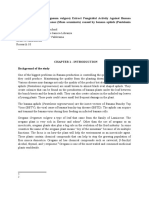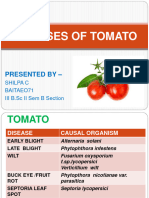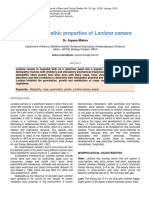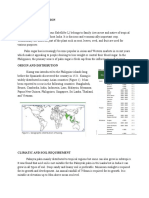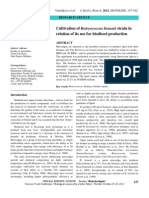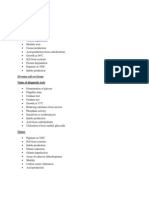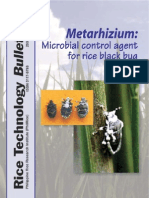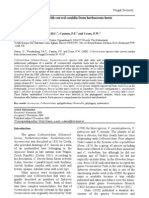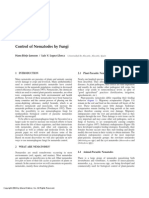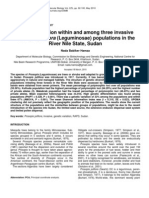Professional Documents
Culture Documents
Fungal pathogen from South America aids control of invasive Lantana camara
Uploaded by
jawad_ali1Original Description:
Original Title
Copyright
Available Formats
Share this document
Did you find this document useful?
Is this content inappropriate?
Report this DocumentCopyright:
Available Formats
Fungal pathogen from South America aids control of invasive Lantana camara
Uploaded by
jawad_ali1Copyright:
Available Formats
THE LANTANA LEAF SPOT FUNGUS
(Mycovellosiella lantanae var. lantanae) 26 DOSSIERS
DESCRIPTION Mycovellosiella lantanae (Chupp) Deighton var. lantanae is a leaf spot fungus originating from South America. It was selected as a fungal biocontrol agent against Lantana camara in South Africa based on field evidence and research, conducted over a decade. The fungus has a broad environmental tolerance and is specific to several of the weedy hybrids of L. camara in South Africa. LIFE
A fungal pathogen of LANTANA (Lantana camara) in South Africa
ON BIOLOGICAL CONTROL AGENTS AVAILABLE TO AID ALIEN PLANT CONTROL
Mycovellosiella lantanae var. lantanae from South America
CYCLE
Spores, produced in chains, are dispersed by wind and rain and infect the plant by entering the natural openings of the leaf. DISEASE
SYMPTOMS
Infected Lantana camara plants develop leaf lesions varying from indistinct, small chlorotic (yellow) spots to large necrotic (dead) patches covering whole areas of the leaf, leading to leaf death. Symptoms appear a month after inoculation in the field. IMPACT LANTANA
Infection through natural opening (stoma)
ON
CAMARA
The lantana leaf spot fungus will not kill the plant. Mycovellosiella lantanae var. lantanae, used in conjunction with the suite of lantana insect biocontrol agents released on the weed in South Africa, will predispose weedy lantana to added stress factors ultimately leading to a reduction in seed production.
Symptoms ranging from indistinct chlorotic spots to necrotic lesions
Mycovellosiella lantanae infection three months post release in the field
Author: ALANA DEN BREEEN, ARC-PPRI, Weeds Research Division, P/Bag X5017, Stellenbosch, 7599 South Africa MORE INFORMATION IS AVAILABLE. PHONE: Weedbuster Toll-free Helpline: 0800 005 376. WEBSITE: Weeds Research Division on ARC-PPRI website: www.arc-ppri.agric.za.
You might also like
- SEM-12093 Crucifer Disease Guide 072313Document51 pagesSEM-12093 Crucifer Disease Guide 072313Decebal ChituNo ratings yet
- IJTRD17921Occurrence, Distribution, Severity and Future Threats of Lantana Bug, Orthezia Insignis Browne (Homoptera-Ortheziidae) in East Harerge Zone, EthiopiaDocument13 pagesIJTRD17921Occurrence, Distribution, Severity and Future Threats of Lantana Bug, Orthezia Insignis Browne (Homoptera-Ortheziidae) in East Harerge Zone, EthiopiaTemesgen FitaNo ratings yet
- UntitledDocument12 pagesUntitledPrincess Jamica LibranzaNo ratings yet
- An Overview of Research On Diseases of Cactus PearDocument6 pagesAn Overview of Research On Diseases of Cactus PearHIMANSHU BARWARNo ratings yet
- Cucumber Mosaic Virus (CMV) : World Vegetable CenterDocument2 pagesCucumber Mosaic Virus (CMV) : World Vegetable CentersameeNo ratings yet
- Resume Xanthomonas Campestris - Fatimah Az Zahra - 2014191006-1Document3 pagesResume Xanthomonas Campestris - Fatimah Az Zahra - 2014191006-1unila satuNo ratings yet
- Alfalfa Mosaic Virus: World Vegetable CenterDocument2 pagesAlfalfa Mosaic Virus: World Vegetable CenterMohamed MohsenNo ratings yet
- Xylophilus Ampelinus: Data Sheets On Quarantine PestsDocument4 pagesXylophilus Ampelinus: Data Sheets On Quarantine PestsClint MuscatNo ratings yet
- Moko Disease Ralstonia Solanacearum: (Race 2, Biovar 1)Document2 pagesMoko Disease Ralstonia Solanacearum: (Race 2, Biovar 1)cindy cabresosNo ratings yet
- diseasesoftomatonew-200728083816 (1)Document35 pagesdiseasesoftomatonew-200728083816 (1)dawit gNo ratings yet
- Mango Malformation TreatmentDocument2 pagesMango Malformation TreatmentShabbir HussainNo ratings yet
- Apple Diseases Diagnostic KeyDocument2 pagesApple Diseases Diagnostic Keyzac2351No ratings yet
- Bridal ChorusDocument5 pagesBridal ChorusDearlyn Panongcoy BeroyaNo ratings yet
- Presentation 1Document20 pagesPresentation 1Omprakash Kumar SinghNo ratings yet
- Important Diseases of Plants - Rust, Downy Mildews and Powdery MildewsDocument40 pagesImportant Diseases of Plants - Rust, Downy Mildews and Powdery MildewsPrajwal BhanuNo ratings yet
- Red Sesbania: Sesbania Punicea (Cav.) BenthDocument2 pagesRed Sesbania: Sesbania Punicea (Cav.) BenthayakashimajorinNo ratings yet
- Plant Viruses: An IntroductionDocument43 pagesPlant Viruses: An IntroductionMahnoorIshtiaqNo ratings yet
- Investigatory ProjectDocument7 pagesInvestigatory ProjectReaFlorSalazarNo ratings yet
- IPM FACTSHEET FOR AMPALAYA FARMERSDocument6 pagesIPM FACTSHEET FOR AMPALAYA FARMERSMarjunex PedrosoNo ratings yet
- Thesis On Lantana CamaraDocument7 pagesThesis On Lantana Camaragbxm8h7g100% (2)
- Blight Disease MangoDocument3 pagesBlight Disease MangoJhon BoNo ratings yet
- Basil Pest ControlDocument2 pagesBasil Pest ControlBurnsrrNo ratings yet
- 1E3ACFF56305Document5 pages1E3ACFF56305batiya urbanusNo ratings yet
- IPM strategies for cassava pests and diseasesDocument31 pagesIPM strategies for cassava pests and diseasesKimi DorsNo ratings yet
- Allelopathic Properties of Lantana CamaraDocument16 pagesAllelopathic Properties of Lantana CamaraSheMaeNo ratings yet
- Jurnal TerbaruDocument7 pagesJurnal TerbaruMaulana SiregarNo ratings yet
- 12 Cereals Rust Pearl MilletDocument2 pages12 Cereals Rust Pearl MilletSajadNo ratings yet
- Protea BrochureDocument2 pagesProtea BrochureTyrese ChumbuNo ratings yet
- Sem-12095 Pepperdiseases 8p5x11 072313Document74 pagesSem-12095 Pepperdiseases 8p5x11 072313marianaluabo3978No ratings yet
- 1 - Fruit - Dise PDFDocument222 pages1 - Fruit - Dise PDFAastha chouhanNo ratings yet
- Pathogenic Identification and ClassificationDocument6 pagesPathogenic Identification and ClassificationErikaruth LabisNo ratings yet
- Late Blight of PotatoDocument20 pagesLate Blight of PotatoShaik Gouse BashaNo ratings yet
- Plant Disease Diagnosis: Anthracnose on Calathea roseopictaDocument20 pagesPlant Disease Diagnosis: Anthracnose on Calathea roseopictaSleeping BeautyNo ratings yet
- 6-Bud RotDocument2 pages6-Bud RotFrank DagohoyNo ratings yet
- C. CoffeanumDocument37 pagesC. CoffeanumMiranda M Guzmán MadrigalNo ratings yet
- Pecan Diseases and Health Risks in South AfricaDocument5 pagesPecan Diseases and Health Risks in South AfricaAndriesNo ratings yet
- Natad, Mary Jane M. Plant PathologyDocument34 pagesNatad, Mary Jane M. Plant PathologyMaryJane NatadNo ratings yet
- FFTC Document Database: Site Search SearchDocument2 pagesFFTC Document Database: Site Search SearchaiktiplarNo ratings yet
- 6 - Common and Important Diseases of Grain Sorghum: Dave Tebeest, Terry Kirkpatrick and Rick CartwrightDocument10 pages6 - Common and Important Diseases of Grain Sorghum: Dave Tebeest, Terry Kirkpatrick and Rick CartwrightmazrilfNo ratings yet
- Botany and Plant PathologyDocument2 pagesBotany and Plant PathologymdollNo ratings yet
- Cultivation and Uses of Palmyra PalmDocument5 pagesCultivation and Uses of Palmyra PalmKaren MapaNo ratings yet
- Banana Xanthomonas Wilt: Xanthomonas Campestris Pv. MusacearumDocument2 pagesBanana Xanthomonas Wilt: Xanthomonas Campestris Pv. MusacearumJahangir AliNo ratings yet
- Compilation (Jenalyn)Document9 pagesCompilation (Jenalyn)Juliet TenoriaNo ratings yet
- Common Diseases of Leafy GreensDocument6 pagesCommon Diseases of Leafy GreensAgung PurnomoNo ratings yet
- Little Leaf ReportDocument11 pagesLittle Leaf ReportGokularamanan Arul 262No ratings yet
- Ms_No._3._Lantana_research__Document5 pagesMs_No._3._Lantana_research__Apoorva SrivastavaNo ratings yet
- Distribution and severity of banana Sigatoka pathogens in Uganda and TanzaniaDocument10 pagesDistribution and severity of banana Sigatoka pathogens in Uganda and TanzaniaRachmadani Heri PutraNo ratings yet
- 450-708 PDFDocument2 pages450-708 PDFsharanNo ratings yet
- Faculty of Agricultural Sciences and Allied Industries Diseases of Field&Horticultural Crops& Management 1 PPA - 312Document8 pagesFaculty of Agricultural Sciences and Allied Industries Diseases of Field&Horticultural Crops& Management 1 PPA - 312Aalok MishraNo ratings yet
- Meena 2019Document7 pagesMeena 2019PANKAJ YADAVNo ratings yet
- Eggplant Production (Simple)Document8 pagesEggplant Production (Simple)Jesanro AmaranteNo ratings yet
- Kentucky Pest News May 24, 2011Document8 pagesKentucky Pest News May 24, 2011awpmaintNo ratings yet
- Blackleg of Canola: Steve Marcroft, Marcroft Grains Pathology, Horsham, Chris Bluett DPI BallaratDocument2 pagesBlackleg of Canola: Steve Marcroft, Marcroft Grains Pathology, Horsham, Chris Bluett DPI BallaratsushantNo ratings yet
- Western Flower Thrips and TSWVDocument7 pagesWestern Flower Thrips and TSWValuormatardummyNo ratings yet
- Management of Insect Pests of TobaccoDocument5 pagesManagement of Insect Pests of TobaccoStaidCasperNo ratings yet
- Mango Anthracnose ThesisDocument4 pagesMango Anthracnose ThesisHelpWithYourPaperLittleRock100% (2)
- Biocontrol and Growth Enhancement Potential of Two Endophytic TR - 2016 - BiologDocument13 pagesBiocontrol and Growth Enhancement Potential of Two Endophytic TR - 2016 - BiologMaria BatoolNo ratings yet
- Plants: Bioactivity of Common Pesticidal Plants On Fall Armyworm Larvae (Spodoptera Frugiperda)Document10 pagesPlants: Bioactivity of Common Pesticidal Plants On Fall Armyworm Larvae (Spodoptera Frugiperda)salif ouedraogoNo ratings yet
- Rice Bacterial Leaf Blight 418Document3 pagesRice Bacterial Leaf Blight 418warriors dynastyNo ratings yet
- Root Rot Diagnosis in Ornamentals PDFDocument4 pagesRoot Rot Diagnosis in Ornamentals PDFjawad_ali1No ratings yet
- Root Rot Diagnosis in Ornamentals PDFDocument4 pagesRoot Rot Diagnosis in Ornamentals PDFjawad_ali1No ratings yet
- Plant Name: Scaevola Category: Ground CoverDocument1 pagePlant Name: Scaevola Category: Ground Coverjawad_ali1No ratings yet
- Managing Light During Propagation PDFDocument4 pagesManaging Light During Propagation PDFjawad_ali1No ratings yet
- Root Rot Diagnosis in Ornamentals PDFDocument4 pagesRoot Rot Diagnosis in Ornamentals PDFjawad_ali1No ratings yet
- Manifold Filtration Unit For Spore SeparationDocument1 pageManifold Filtration Unit For Spore Separationjawad_ali1No ratings yet
- DNA MethylationDocument10 pagesDNA Methylationjawad_ali1No ratings yet
- Waste Cooking Oil As Alternate Feedstock For Biodiesel ProductionDocument16 pagesWaste Cooking Oil As Alternate Feedstock For Biodiesel Productionjawad_ali1No ratings yet
- 3-2 MicrobiologicalQualityControlDocument37 pages3-2 MicrobiologicalQualityControlabdullah2020No ratings yet
- Cultivation of Botryococcus Braunii Strain PDFDocument6 pagesCultivation of Botryococcus Braunii Strain PDFjawad_ali1No ratings yet
- 3-2 MicrobiologicalQualityControlDocument37 pages3-2 MicrobiologicalQualityControlabdullah2020No ratings yet
- Diagnostic Tests For Plant Pathogenic Bacterial GeneraDocument3 pagesDiagnostic Tests For Plant Pathogenic Bacterial Generajawad_ali1No ratings yet
- MetarhiziumDocument16 pagesMetarhiziumjawad_ali1No ratings yet
- Colletotrichum SPPDocument43 pagesColletotrichum SPPjawad_ali1No ratings yet
- SemesterDocument2 pagesSemesterjawad_ali1No ratings yet
- Colletotrichum SPPDocument43 pagesColletotrichum SPPjawad_ali1No ratings yet
- Control of Nematodes by FungiDocument11 pagesControl of Nematodes by Fungijawad_ali1No ratings yet
- DNA Extraction From ProsopisDocument9 pagesDNA Extraction From Prosopisjawad_ali1No ratings yet


